
Do You Need to Know Your Myths? |
| by Fiona Clements |
My premise, presented in this article, is that you don’t have to have an encyclopaedic knowledge of the world’s myths in order to write good horror fiction, but that it is important to have a firm understanding of the human needs that generated those myths. I think of these needs as the “motive force” behind mythology, and that’s what I’m dealing with here. Why is this relevant to horror fiction? Because the motive force is 90% fear (10% awe), so if you understand what makes people afraid and what people do with these fears, then the chances are increased that you will produce good horror stories. If you don’t have this understanding, no amount of research into Bastet, Loki, Baba Yaga, or the hierarchies of heaven and hell will make up the difference - although you may win points with any god-spotters out there. |
In order to convert you to this premise, I’m first going to expand on my definition of the motive force, and I’m then going to illustrate the value of the premise by looking at four comics and pronouncing judgement upon them. The four comics are all single issues of titles that are currently in the Vertigo line - I chose Vertigo because it’s primarily a horror line so gives a wide selection. In fact, three of these issues appeared before Vertigo started, but the titles were later included in the Vertigo stable so I don’t feel I’m cheating too much. |
Oh, and I should also say that I use the term “mythology” to include religion, and that I’m an atheist. If we’re never going to understand one another, best you know that now, rather than ten paragraphs in. |
More on the Motive Force |
It’s a frightening thing, being born a member of an intelligent species. Most creatures have only enough brain to handle their instincts and to process sensory data and motor commands, and at times that has a certain appeal. It seems unlikely that stick insects and haddock lie awake nights wondering who or what makes summer come back each year, or why their mate died while so many others were spared. They’re lucky, these creatures: they’re born with a rule book that tells them all they need to know to survive and reproduce, and they’re born without the capacity to speculate about the things that aren’t covered by the rules. Humans, on the other hand... |
Here at the end of the twentieth century, we know what makes the sun come up each morning, and what produces the sequence of the seasons, and it can be difficult to imagine the anxiety of the people who did not know. Faced with the treasures of Tutankhamun in the Cairo Museum, our guide had only a vague explanation for the awe-inspiring investment of wealth and effort into this insignificant boy: natural grief, of course, and then some tenuous link between the riches of the pharoah and the riches of the nation. He gave no hint of what seems likely to me: that they felt that they had to get the pharoah safely into the underworld to mate with the cow-goddess Hathor (the mother of all) and thus continue the processes of life. It was literally a matter of life or death for them, and the scale of the investment shows the intensity of their need and belief - it is a measure of the motive force. |
|
Those particular fears are no longer with us, but there are many others that science will probably never dispose of, and that are usually expressed in questions to the gods. “How did life start?” “How will it end?” “What is the purpose of life?” “What happens after death?” “What is the function of suffering?” “If people do harmful things and are not caught or punished in their lifetimes, will they ever be punished?” “Do my emotions and thoughts - which I regard as the main features of my life - have any real or lasting importance?” “What is my relation to other creatures and to other people?” “What is the significance of strange and unusual objects and events?” And above all [with a note of desperation]: “What do you want me to do?” |
|
All difficult questions, and all utterly crucial. It’s a rare person who can shrug and say, “Don’t think there’s any purpose and can’t say it bothers me.” There seems to be a compulsion - our“motive force” - to develop theories in order to answer these questions. If the theories are developed and presented through structured debates, then they come under “philosophy”. However, many theories are developed and presented in the form of stories, and these come under “mythology” - where a set of related stories is a “mythological system”. Different systems emphasise different fears and questions: some are particularly concerned with justice, others with suffering, some with the uniqueness of humans, others with the common condition of all things. Still, when you immerse yourself in any one of the systems, you will feel that all of the fears are being soothed and made bearable - even if they’re not usually removed completely. |
Armed with this very general approach to mythology, I’m now going to tackle my four comics. Their storylines aren’t related, and neither are the mythological issues that they address or ignore, so for simplicity I’ve decided to deal with them in chronological order. I don’t think there are any historical trends, but I could be wrong. |

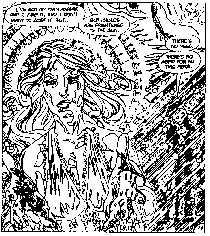
Swamp Thing 43, December 1985 |
by Alan Moore, Stan Woch and Ron Randall |
This issue is a short story entitled “Windfall” and it stands on its own in the Swamp Thing storyline. It can probably be read in isolation, although it might help to know that the tubers growing on Swamp Thing have psychedelic properties, an idea which had been introduced a few issues previously. |
At the beginning of this story, one of the tubers drops to the ground and is found by Chester, a hippy. He takes it home and is trying to identify it when he receives two visits. The first visit is from Dave, whose wife Sandy is in terrible pain with terminal cancer, and who has come in the hope that Chester will have some drug that will ease the end for her - Chester hasn’t but he thinks the tuber might be a psychedelic, and Dave takes the offered slice, saying, “It can’t make her any worse, can it?” The next visit is from Milo, a threatening, foul-mouthed druggie who is here because: “My main connection is away on business, an’ I feel like gettin’ screwed up tonight.” He spots the tuber and steals a slice (well, says he’ll pay Chester later), ignoring Chester’s warning that the tuber hasn’t been checked out yet. |
The next section of the story alternates page by page between the two experiences of the drug. |
Sandy has a revelation of the unity of all things: “Life. It’s all life. You. Me. Everything. It’s all the same thing, like an ocean, but all divided up and contained in separate bottles... [...] The water changes from solid to liquid to gas, moving around the planet. ... and there’s separate icicles that melt and vanish, separate puddles that dry up and they’re gone but they’re not gone, they just changed state is all... [... ] I’ve got my own shape, and I like it, and I don’t want to lose it, but icicles are frightened of the sun. There’s no need. There’s no need for all this fear.” And she dies that night without fear or pain. |
Milo, on the other hand, is plunged into a hallucination in which he is the Swamp Thing: dying in flames, emerging from the swamp to find himself changed into a monster, and then staggering through a city that is peopled with the horrors that Swamp Thing has encountered. He does not cope with this as well as Swamp Thing did. “This is what the world’s really like, isn’t it? I can see it now. We’re all monsters! We’re all deformed things, living in hell... Everything just dies and rots, gets fulla bugs, mindless bugs, eatin’ each other... It’s horror. It’s all horror...” In his panic he runs into the road, and is killed by a truck. |
We then return to Chester’s apartment, where Dave is telling Chester that Sandy is dead, but that the tuber had transformed the experience, and given her last moments some meaning. After Dave had left, a junkie turns up to blame Chester for what happened to Milo, and to ask him if he has any more of the stuff! By this time, Chester has decided that the tuber is: “like some kinda cosmic litmus paper, right? You eat it, an’ it tells you whether you’re a bad person or a good person.” Left on his own, Chester studies the last slice of tuber and does some hard thinking. “I dunno, man. I really don’t know. I think I’m a good person. I mean, that’s what I try to be... I don’t abuse the planet, or other people, and I’m never violent or anything... But, like, I still each meat, and I sometimes think some pretty bad things... I said some stuff to Suzanne before she left, and I wish I hadn’t said it. I was so bitter.” He picks the slice up, raises it to his open mouth... then puts it back on the plate and turns away. The End. |
I initially picked this story for discussion because I was impressed with the way it highlighted our fears about our personal moral worth shown through Chester’s decision at the end. I think that most people brought up in a Christian culture believe, at some level, that one day they will be judged. And yes, that is frightening, but there’s reassurance in the idea that the people you think are really bad will also be judged, and in the thought that the judgement will occur some other day and when you’re dead. But to find out now, this minute, while you’re still alive... No. I would have put the tuber back on the plate too. |
That aspect of the story is just as impressive as I remembered, but in the process of writing this article I also realised that the story’s contact with the motive force is firmer even than that. In their experiences with the drug, Sandy and Milo are both developing their own theories about the meaning of life and their place in it - or, in other words, they are developing their own mythological systems, each with its own character and conclusions. |
It’s obvious that I approve of this story in terms of the purpose of this article, but while I’m on the subject, I want to say that this is one of my favourite short stories, in any medium or genre. It’s a superb piece of work, probably most remarkable in the sequence of pages which alternate between Sandy and Milo: the beauty and serenity of Sandy’s pages bring tears to my eyes, and the contagious guilt of Milo’s pages make me ashamed to be human - and the writing and artwork allow these emotions to switch back and forth effortlessly within a fraction of a second. Stunning. |

Hellblazer 31, July 1990 |
by Jamie Delano and Sean Phillips |
This issue - “Mourning of the Magician” - is a complete episode in the Family Man storyline (about a serial killer who targets families). Again, it can probably be read on its own. |
Constantine’s father has recently died, murdered by the Family Man, and Constantine’s niece Gemma is receiving visits from her grandfather’s spirit at night, and is very disturbed by this. She’s pinning her hopes on Constantine, who is coming up for the funeral: “He’d know how to help. Uncle John knew about ghosts.” The ghost is still around after the cremation, now badly charred and looking extremely unhappy. Gemma tells Constantine what’s happening, and he suddenly realises why the haunting is occuring, and that it’s nothing to do with the traditional “soul traumatised and disoriented by a violent death”. Instead, it dates back to his adolescence and a spell he cast on his father in revenge for the burning of his occult books. This spell involved the body of a cat - now buried in his mother’s grave - and when he digs up and burns this body, the haunting stops. The End. |
When I first started reading this issue six years ago, I thought Delano was using the haunting as a way of discussing the complicated emotions that are generated by a death, most particularly the anger and resentment at the dead person for causing these painful feelings in yourself and those around you. During the funeral, we get Gemma’s point of view: “Why is he tormenting her? She used to like him - she doesn’t want to remember him like this.” Nicely put, I thought. But then the potential for making a general, useful and painful point about human nature is steadily (even ruthlessly) whittled away until we’re left with something that has relevance only to John Constantine - and that also allows the grief and distress to disappear “magically” as soon as the cat is burned. |
Oh, dear. You know, I wouldn’t even be mentioning this issue if Delano hadn’t got so close to some of those fundamental fears and questions: What happens after death? Do our strong emotions have a significance and existence of their own? It could have been a really disturbing and valuable story, but he couldn’t look those fears squarely in the eye - or wasn’t even aware that they were there? - and instead we got this occult trivia which is, in my opinion, an active denial of the human condition. |
It’s not that I mind supernatural elements being included in stories - Swamp Thing’s tubers aren’t in any botany textbook that I know of - but if it is to be a good story then I think the elements have to work as metaphor as well, which the tubers do in the Swamp Thing story, and which the dead cat here most definitely doesn’t. Well, unless we’re going down the Freudian Oedipal road, and with me in the driving seat, we are not. And it isn’t frightening either, a heinous offence in a horror story. On a scale of 1 to 10: -5. |
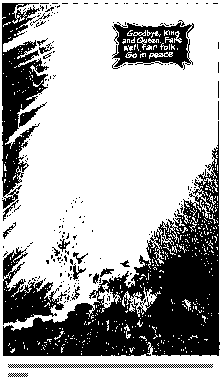
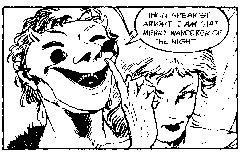
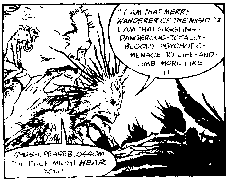
Sandman 19, September 1990 |
by Neil Gaiman and Charles Vess |
This is “A Midsummer Night’s Dream” - the issue which won the World Fantasy Award a few years ago. You probably know the story, but just in case... |
In an earlier issue, Morpheus encountered William Shakespeare, then a talentless wannabe playwright, and he made a deal with Shakespeare: he would give the man talent, and in exchange would receive two plays that celebrated dreams and the faerie race. The first of these plays is “A Midsummer Night’s Dream” (the subject of this issue) and the second is “The Tempest” (the subject of Sandman 75). In this issue Shakespeare’s troupe has stopped in a deserted part of the English countryside and is giving a special performance of the play at the insistence of Morpheus. The audience consists entirely of faerie creatures, including those featured in the play: Titania, Auberon, Puck, Peaseblossom, etc. The play proceeds in the background of the story, while the story itself deals with the reactions and interactions of the rnortals and immortals. |
It’s very well crafted, with artwork that makes the faeries truly alien and unsettling, and with lively dialogue that frequently makes you laugh out loud. And I find the whole idea deeply offensive and wish it had never been done. |
I seem to be the only person who feels like this, so this may take some explaining and I ask you to bear with me if you haven’t already wandered off muttering about my mental health. It comes down to the questions raised by human marvels, by genius. Talent on the scale of Shakespeare’s isn’t the type that makes you say, “Gosh! I wish I could write like you.” - it’s the type that turns your guts to ice if you let yourself stop and think about it. OK not everyone’s affected by his plays - “So you think he was more than just an unusually successful hack?” said one of my fellow-editors when I was discussing this article - but consider that of the 17,677 different words he used in his writings, more than one in ten had never been used before. No single person in any language has ever been more creative with words and phrases. I don’t know about you, but I find that idea purely terrifying, on the level of the other fundamental fears. And I do think this reaction must be quite common, or there wouldn’t be so many attempts to deny his authorship: it is somehow easier to deal with the fear if you can say, “Well we don’t really know who wrote them,” rather than, “Yes, we know who wrote them and it was this perfectly ordinary man who you or I might have known if we’d been alive then.” |
I’m sorry, folks, but genius is just something that happens to humans sometimes, and it’s high time we learned to deal with this fact and stopped trying to push the blame somewhere else, onto some unknown individual or onto the gods. That is my problem with this comic, and for me it is an enormous problem - it means that I am going to feel cheated and insulted by any story that Gaiman builds around this idea of the origin of Shakespeare’s talent, regardless of the skill he brings to the writing and regardless of his choice of plays to adapt (I don’t like the “Dream” - I love “The Tempest”). Why cheated? Because I want my terror back, and these little entertainments are not an adequate exchange. Why insulted? Because I feel I’ve been treated like a child (who can’t face the terror) or like a fool (who won’t even notice she’s been cheated). If this means I’m ridiculously hard to please, so be it. |
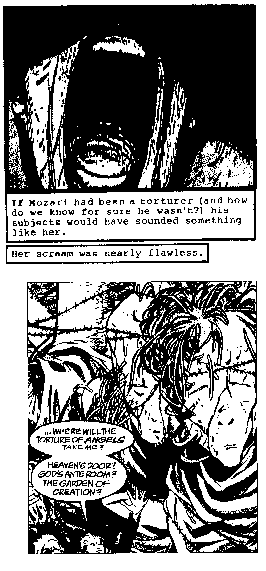
Shade the Changing Man 34, April 1993 |
by Peter Milligan, Chris Bachalo, Glyn Dillon and Rick Bryant |
This issue is “Growing Pains” - Part 2 of a three-part story called “BirthPains”. I can’t say it makes that much sense on its own, but I’ve chosen it because it’s the first issue of Shade I ever read and even with no idea who the characters were or what was going on, it was still the most exciting comic I’d read in months. |
I won’t attempt to describe the plotline but will zoom right in on the reason I’m including it in this article: Brian Juno, who is a transcendental torturer (my phrase). Juno believes that the pain of others can transform him into a god. “It is the only way I can reach the Garden of Pain. This is my spiritual route. As Mahatma Gandhi said, all roads lead to God. My road is simply a little less trod than most. It’s not as though I enjoy torture, any more than a monk enjoys chastity, or a flagellant enjoys whipping himself.” Juno has obviously been transfixed by one particular fundamental question: “What is the function of suffering?” - and has decided that it is the foundation of the universe, rather than a hint that mankind should change its ways. He wouldn’t be the first person to come to this conclusion, though this offering of someone else’s suffering for spiritual purposes seems to be more common in the east than the west - the cult of Kali (performing human sacrifices until the ban in 1835) versus the Marquis de Sade. |
Milligan has done a beautiful job of taking you inside Juno’s mind, and while you’re there you can ... well, you can sort of see the psycho’s point. Milligan has taken a frightening question and given a suitably frightening answer, and I am full of admiration. Not that I’d want to read a story like this more than once a year, mind - it’s almost enough to make me go out shopping for a nice cosy religion, one with friendly bears and giggling trees. Almost. |
In Conclusion... |
I find this a productive and instructive way to look at horror comics. Maybe you could say I’m taking some aspects too seriously, but sometimes you can have more fun when you take things seriously: taken on its own Hellblazer 31 is just plain awful, but taken seriously, it can provoke thought and spark off a good, invigorating rant. Maybe you have an approach of your own that provides the same benefits - though not necessarily for horror stories. I’d be interested to hear about it. |
References |
[11 Joseph Campbell, 1976, The Masks of God: Oriental Mythology, Penguin. |
[2] Bill Bryson, 1990, Mother Tongue: The English Language, Penguin |